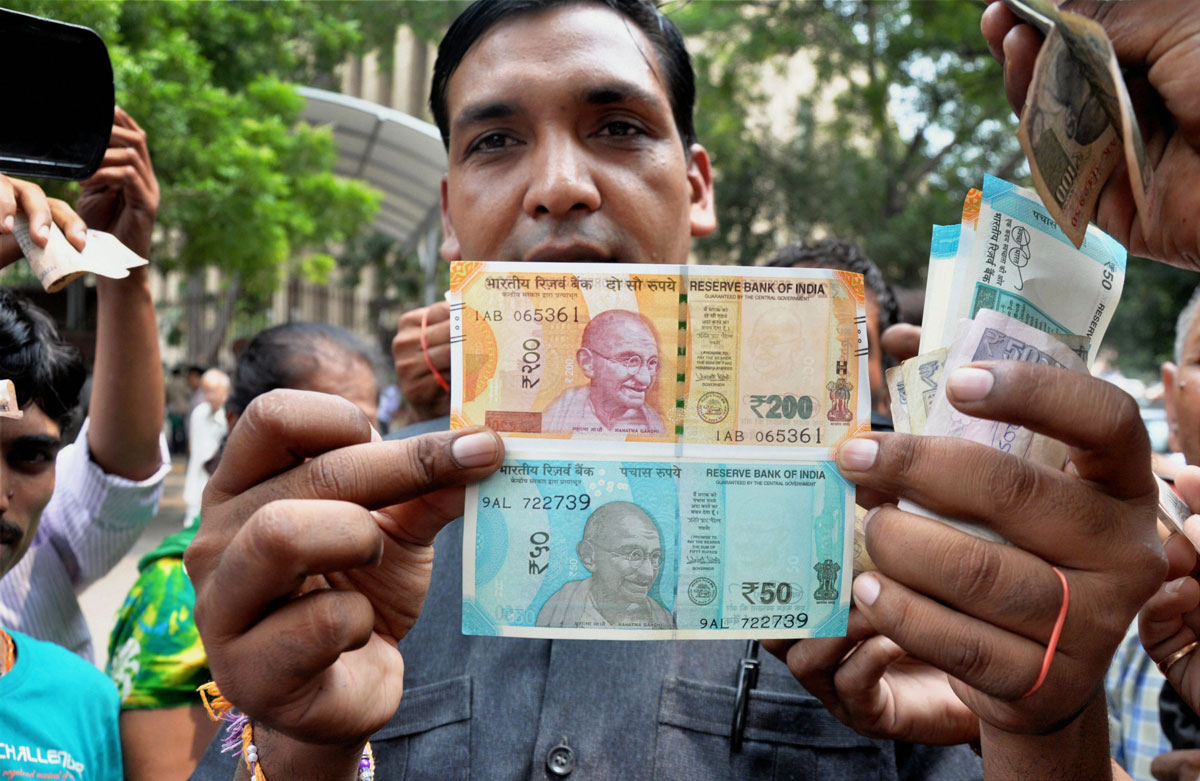New Currency Notes Introduced in India
A man shows new currency notes of Rs. 200 and Rs. 50 outside the Reserve Bank of India in New Delhi, Aug. 25. This is the first time that Rs. 200 banknotes were introduced in India. (Press Trust of India)
The Reserve Bank launched Rs. 200 notes for the first time, Aug. 25, saying it will make it easier for the common man to transact in lower denomination “missing link” currency and bring greater efficiency into the system.
The bright yellow-colored Rs. 200 notes hit the market just a day after the finance minister gave go-ahead to the RBI to issue the new currency bill.
Following the demonetization of Rs. 1,000 and Rs. 500 notes last November, the central bank had introduced Rs. 2,000 notes and new Rs. 500 notes.
The transition had led to severe cash shortage in the economy and put pressure on low value notes.
The Reserve Bank of India issued Rs. 200 denomination banknotes in the Mahatma Gandhi (new) Series, bearing signature of Urjit R. Patel, Governor, Reserve Bank of India from select RBI offices, and some banks, Aug. 25.
As per the new policy on theme-based currency notes, the Rs. 200 bill bears motif of Sanchi Stupa to depict India’s cultural heritage.
The base color of the note is bright yellow, RBI said.
In a separate statement, it said that Rs. 200 note will provide the “missing link” and ensure optimal mix of currency denominations.
India has currency denominations of Rs. 1, 2, 5, 10, 20, 50, 100, 500 and 2000. As such, in the lower end of the denomination series, Rs 200 has been the missing link. The RBI had recently introduced Rs. 50 note with a new look and additional security features.
“To achieve the optimal system of currency that would minimize the number of denominations while increasing the probability of proffering exact change, especially at the lower end of denominations, there is a logical need to introduce the missing denomination of Rs. 200, which will make the present currency system more efficient,” RBI said.
Provision of the new denomination, therefore, would facilitate exchange, particularly for the common man who deals with denominations at the lower end, it added.
Now, with the introduction of Rs. 200 notes, the problem people have been facing due to high-value Rs. 2,000 notes is expected to be resolved.
Recently, the RBI had introduced new fluorescent blue notes of Rs. 50 bearing the motif of ‘Hampi with Chariot.’
Among prominent features, the Rs. 200 banknote carries a portrait of Mahatma Gandhi at the center and the denominational numeral “200” with rupee symbol in color changing ink—green to blue—on the bottom right on the obverse (front) side of the note, RBI said.
For visually impaired, the front side of the note will have intaglio or raised printing of Mahatma Gandhi portrait, Ashoka Pillar emblem, raised identification mark ‘H’ with micro-text Rs. 200, four angular bleed lines with two circles in between the lines both on the right and left sides.
The reverse side of the note carries a “Swachh Bharat” logo with slogan and the Sanchi Stupa motif, RBI said.
RBI said the introduction of a new currency denomination and design is done keeping in consideration various factors like ease of transactions for the common man, replacement of soiled banknotes, inflation and the need for combating counterfeiting.
The optimal system of denominations of currency (coins and notes), RBI said is one that would minimize the number of denominations and concurrently increase the probability of proffering exact change.
“So, what should be the optimal mix of currency denominations?
Many countries have opted to use a near variation of the Renard Series, i.e., 1:2 or 1:2.5 ratio between adjacent denominations of currency, which means that the denomination should be twice or two and half times of its preceding denomination,” the central bank said.
Such a ratio allows exchange of value ordinarily in a maximum of three denominations, it added.
Finance Minister Arun Jaitley said, Aug. 23, that the government is not considering banning Rs. 2,000 notes.


